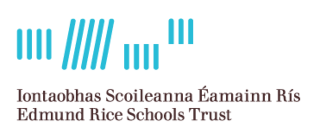Some Frequently Asked Questions
-
What is the Edmund Rice Schools Trust?
The Edmund Rice Schools Trust is an educational lay trust, established in 2008, with responsibility for the 96 former Christian Brother schools in the Republic of Ireland. It is a company, with charitable status, whose business is conducted by Members, Directors and an Executive team. The primary objective of the Trust is to ensure and foster the advancement of education and to further the aims and purposes of Catholic education in the Edmund Rice tradition, in colleges, schools and other educational projects in Ireland, owned or operated by the Company, in accordance with the religion and education philosophy of the Company, as stated in the Edmund Rice Schools Trust Charter.
- What is the difference between Members and Directors?
- Who makes up the Edmund Rice Schools Trust office?
- What is the role of the Edmund Rice Schools Trust office?
- What is the objective of the Edmund Rice Schools Trust?
- What is the Charter?
- What is the Edmund Rice Schools Trust’s position on students of different faiths?
- What is the Edmund Rice Schools Trust’s position of the teaching of Religious Education and students opting out of RE class?
- What does the Edmund Rice Schools Trust logo mean?
